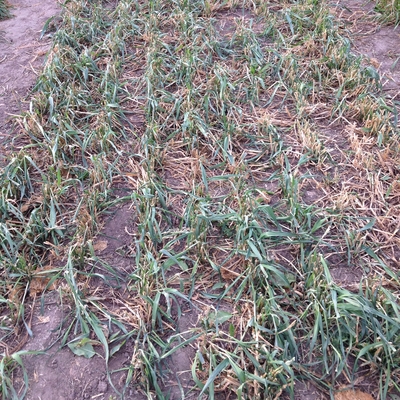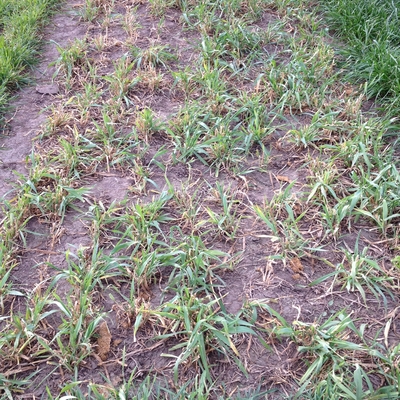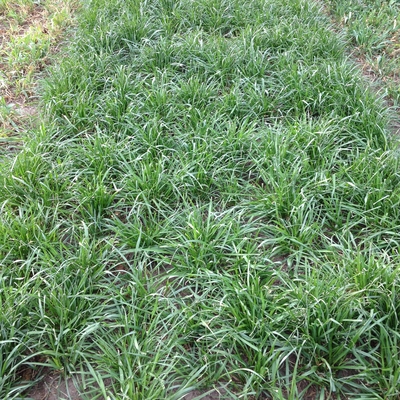Quick facts
Annual ryegrass is a good option for horse owners looking to extend the grazing season or when in need of emergency forage during the summer and fall seasons.
The annual grasses in our study would meet the crude protein and digestible energy requirements of many classes of adult horse.
One of the biggest expenses of owning a horse is feed costs. Pastures can provide an economical source of forage for horses, and a well-managed pasture can meet or exceed the dietary requirements for many classes of horses. Making sure you're getting the most out of your pasture can help reduce feed costs.
In a two-year study (2013 – 2014) of cool-season annual grasses as forage alternatives, we evaluated the following:
- Horse preference
- Yield
- Yield distribution
- Forage nutritional values
Based on a combination of these factors, we found that annual ryegrass appears to be a good option for horse owners looking to extend the grazing season or when in need of emergency forage during both the summer and fall seasons.
Extending the grazing season
In the upper-Midwest, cool-season perennial grasses are the foundation of productive horse pastures. But there may be opportunities to use other forages, such as annual cool-season grasses, to extend the grazing season to earlier in the spring or later in the fall.
Annuals also can be used to provide forage in emergency grazing situations when perennial forages are lost following winterkill, floods or drought.
Spring and summer seeding
We seeded the following in the spring and grazed them during the summer.
- Spring barley
- Spring oat
- Spring wheat
- Winter wheat
- Annual ryegrass
We also seeded these same five grasses as well as winter barley, winter rye and a forage-type spring oat in the summer and grazed them in the fall.
- Prior to grazing, we evaluated all grasses for maturity and took samples to determine yield and forage nutritive values.
- Adult horses grazed all grasses for 4 hours, beginning in June for summer-grazed grasses and beginning in September for fall-grazed grasses.
- Immediately after grazing, we determined which grasses horses preferred by looking at how much of the available forage was eaten on a scale of 0 (no grazing activity) to 100 (100 percent grazed).
- We mowed the grasses to an even height and allowed them to regrow, and then we repeated grazing.
Distinct grass preferences
Horses showed distinct preferences for certain grasses. In general, horses preferred annual ryegrass, spring wheat and winter wheat, which they ate in a range from 35 to 94 percent.
Horses didn't like spring oat, spring forage oat, winter barley and winter rye, as much. They only ate 7 to 32 percent of these grasses.
Yield differences
Among the summer-grazed grasses, yields were typically higher for annual ryegrass and spring oat (1.7 to 2.1 tons per acre) and lower for spring wheat, spring barley and winter wheat (1.1 to 1.8 tons per acre).
Among the fall-grazed grasses, yields were typically higher for spring forage oat, annual ryegrass, and winter barley (1.2 to 2.9 tons per acre) and lower for spring wheat, spring barley and winter rye (0.9 to 1.9 tons per acre).
Regrowth potential for future grazing
A greater amount of regrowth following grazing means you will have more forage available for grazing later on.
In general, annual ryegrass and the winter species (winter wheat, winter barley and winter rye) had the best regrowth after grazing. These produced more even and consistent yields across subsequent grazing events.
In contrast, spring barley, spring oat and spring wheat produced most of their total season yield during the first grazing. But they had little to no regrowth available for subsequent grazing events.
Nutritional values
Forage nutritive values differed among the annual grass species. Plant maturity affected nutritive values, where winter species remained more vegetative and generally had greater forage nutritive values compared to spring species.
However, all grasses contained:
- 18 percent or more crude protein
- 58 percent or less neutral detergent fiber
- 17 percent or less nonstructural carbohydrates
- 2.08 megacalories per kilogram or more of equine digestible energy
In turn, all grass would meet the crude protein and digestible energy requirements of many classes of adult horse.
For more information
The research paper includes data charts and forage nutritive value comparison tables.
Reviewed in 2024




